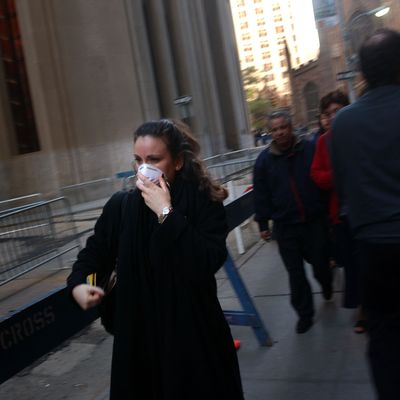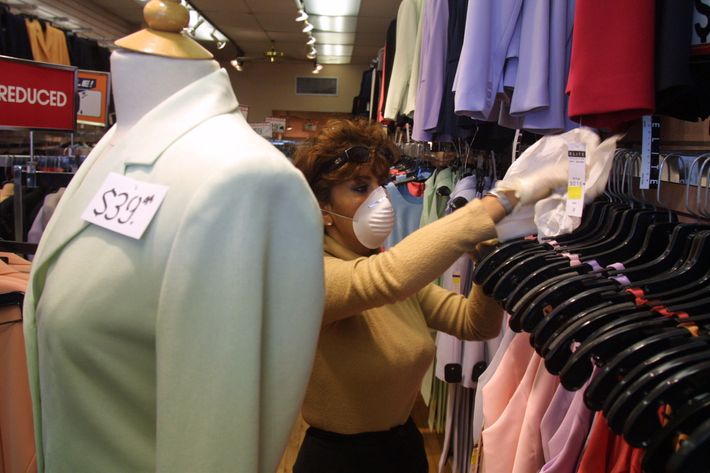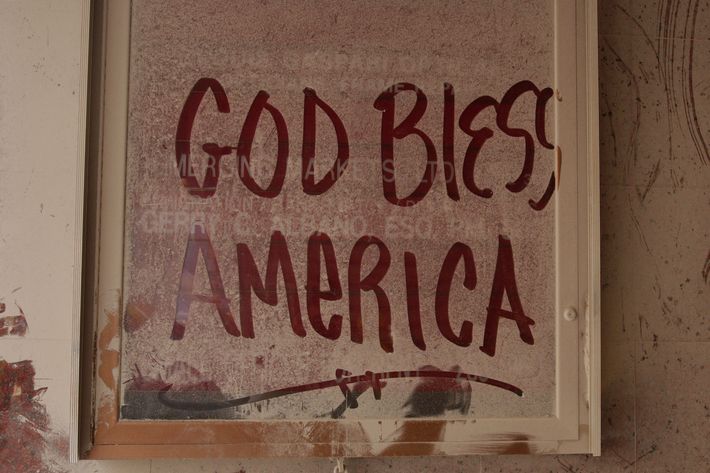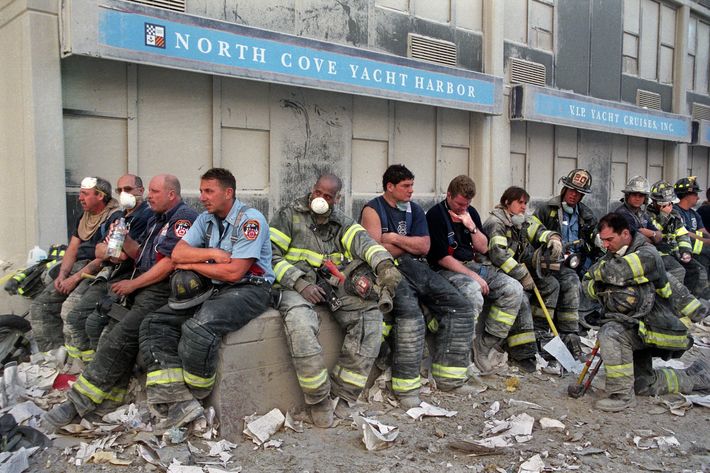
Within days of the attack on the World Trade Center on September 11, 2001, then EPA chief Christine Whitman infamously encouraged New Yorkers to head back to Lower Manhattan. “The good news continues to be that air samples we have taken have all been at levels that cause us no concern,” she told reporters. A week later, she again assured the public that the air was “safe to breathe and their water is safe to drink.” Her claims were echoed by then New York City mayor Rudy Giuliani who, in his apparent eagerness to get the Financial District up and running again, told everyone “to go back to normal.” He also called the air around Ground Zero “safe as far as we can tell, with respect to chemical and biological agents,” even as experts warned that it was not. “You won’t see any immediate problems,” Mount Sinai’s Dr. Philip Landrigan told the New York Daily News on September 13, describing the risks of exposure to the wreckage of the Twin Towers. “It will take 25 to 30 years to develop.”
Rescue and cleanup crews were permitted to dig through Ground Zero without respirators and neighborhood residents and workers attempted to return to their daily lives as poison was being released all around them. As Newsweek explained earlier this week:
When the towers came down…they released a massive plume of carcinogens, turning lower Manhattan into a cesspool of cancer and deadly disease. “We will never know the composition of that cloud, because the wind carried it away, but people were breathing and eating it,” [said the World Trade Center Health Program’s Dr. Michael Crane]. “What we do know is that it had all kinds of god-awful things in it. Burning jet fuel. Plastics, metal, fiberglass, asbestos. It was thick, terrible stuff. A witch’s brew.”
Because the fires burned at Ground Zero for more than 90 days, a later study explained that the contaminants found in the dust immediately after the attacks continued to show up in samples for weeks.
By the time Whitman and Giuliani received significant criticism (Whitman was sued in 2006, and finally apologized this week; Giuliani faced protests during his 2007 presidential campaign), the damage was done, though its scope still isn’t fully clear. Fifteen years after 9/11, here’s some of what we know about how the destruction of the Twin Towers has affected New Yorkers’ health:

Lots of people might not be getting treatment
According to the Centers for Disease Control, roughly 400,000 people — including “rescue and recovery workers, residents, students and school staff, building occupants, and passersby” — were exposed to “the immense cloud of dust and debris, the indoor dust, the fumes from persistent fires, and the mental trauma” of the Twin Towers’ collapse. As of June 2016, only 74,968 were enrolled in the World Trade Center Health Program. (The program, established by the James L. Zadroga 9/11 Health and Compensation Act in 2011, provides federally funded monitoring and treatment of health problems stemming from 9/11.) 56,580 of enrollees were FDNY or other responders — people who, at this point, know quite well that they are at risk of falling ill.
Meanwhile, only 8,881 civilians have enrolled: “I don’t know, really, what the psychology is behind it all,” WTC Environmental Health Center executive director Terry Miles told WYNC several years ago. “I believe people just don’t want to be sick from 9/11. They just don’t. And they don’t want their kids to be sick from 9/11, either. But the fact is people are sick because of the fallout.” Either way, as Newsweek noted, that means that hundreds of thousands of people susceptible to 9/11-related illnesses “remain untreated and unaccounted for.”

The dust hung around for way longer than it should have
According to analysis published in 2002, the aforementioned dust that settled on the area around Ground Zero contained, among other things, “construction materials, soot, paint (leaded and unleaded), and glass fibers (mineral wool and fiberglass),” metals, and asbestos. The study concluded that, “These results support the need to have the interior of residences, buildings, and their respective HVAC systems professionally cleaned to reduce long-term residential risks before rehabitation.” In many cases, that didn’t happen. Cleanups involving asbestos are generally handled by specialists, but, as Discover reported:
Initially, the New York City Department of Health (NYCDOH) took the lead in implementing an indoor cleanup program, which placed the responsibility for asbestos removal directly on landlords and residents themselves, in direct violation of city, state, and federal laws and at an enormous potential health risk.
Without clear guidance, the landlords were “free, if you will, to do whatever they wanted, or to do nothing,” the New York Committee for Occupational Safety and Health’s David Newman told the L.A. Times. “It was kind of a Wild West.” A Tribeca resident who spoke to Discover said that she received a letter from the NYCDOH instructing her to clean her apartment herself using “a wet rag and use a High Efficiency Particulate Airfilter vacuum.” A man who was living in a Brooklyn Heights dorm said that nobody ever told him that the dust he found in his vents and air conditioner was potentially dangerous. “When we turned it on, the dust would blast into the room,” he said, explaining that he and his roommate repeatedly cleaned it up themselves. In 2007, the superintendent of a building located a couple blocks from Ground Zero told the New York Times that he was still finding the dust in the ceilings and walls. Meanwhile, much of the “professional” dust removal was performed by cleaners – many of them immigrants – who weren’t properly trained or equipped for the task. Two such workers told the L.A. Times that they wore paper masks only “30% of the time” they spent vacuuming dust from air vents. All of those people subsequently developed respiratory problems.

Survivors suffer from alarming rates of asthma, gastroesophageal disease, PTSD, cancer, and other illnesses
In 2009, a study of World Trade Center Health Registry enrollees showed that 10.2 percent had received a new diagnosis of asthma in the five to six years following the attack. Rescue and recovery workers were the exposed group most likely to develop asthma (12.2 percent did), followed by passersby (8.6 percent). “Intense dust cloud exposure on September 11 was a major contributor to new asthma diagnoses for all eligibility groups: for example, 19.1% vs 9.6% in those without exposure among rescue/recovery workers. … Asthma risk was highest among rescue/recovery workers on the WTC pile on September 11.” Other “persistent risks” included “not evacuating homes, and experiencing a heavy layer of dust in home or office.” A study conducted from 2011 to 2012 found that of 2,500 people diagnosed with asthma in the two years after 9/11, two-thirds reported continued symptoms “that interfered with their usual activities.”
A 2011 study of the same population found a significant number of post-9/11 gastroesophageal reflux symptoms (GERS). (The symptoms are associated with gastroesophageal reflux disease [GERD], which can lead to esophageal cancer.) Twenty percent of those surveyed reported GERS two to three years after the attack, while 13 percent said that the symptoms persisted for five or more years. Of the people who developed symptoms right after the attack, 46.5 percent still had them ten years later. As with asthma, the illness was most common among responders (41 percent), but people exposed to the initial dust cloud and those who didn’t evacuate their homes were also at an elevated risk.
These and other studies also noted that both asthma and GERS occurred more frequently in patients who also had PTSD (which affected at least 15 percent of people in the vicinity of the attack), though plenty of people without the psychological condition developed one (or both) of the physical illnesses.
The 2011 Annual Report on 9/11 Health also pointed to continuing cases of sarcoidosis (inflammatory cells on the lungs, skin, eyes, and lymph nodes) among responders, residents, and passersby. It also noted a host of ongoing respiratory sickness among exposed firefighters, including sinus inflammation (17.2 percent), bronchitis (13.2 percent), and COPD/emphysema (1.5 percent).
Technically, researchers have yet to definitively link Ground Zero exposure and cancer, but the connection has become obvious. Earlier this week, Newsweek reported that, “As of June, 5,441 of the 75,000 people enrolled in the World Trade Center Health Program have been diagnosed with at least one case of 9/11-related cancer. … And many of them have multiple cancers, with the total number of cancers certified at 6,378 as of June.” The FDNY told the magazine that cancer rates among firefighters and EMTs who worked at Ground Zero are now “19 to 30 percent higher” than they were before 2001.
Meanwhile, from the NYC Health Department:
The Registry first examined cancer incidence from 2003 to 2008 in a study that found more cases than expected of prostate cancer, thyroid cancer, and multiple myeloma among rescue/recovery workers enrolled in the Registry, compared to the general New York State population. The article “Ten-year cancer incidence in rescue/recovery workers and civilians exposed to the September 11, 2001 terrorist attacks on the World Trade Center” presents findings from a follow up study of cancer incidence. The study found that for all cancer sites combined from 2007-2011, there were 11 percent more cancer cases than expected among rescue/recovery workers, and 8 percent more among civilian survivors compared with the New York State general population. Prostate and thyroid cancer remained elevated among rescue/recovery workers. There were also a small, but higher than expected, incidence of skin melanoma in rescue/recovery workers and non-responder civilian survivors. Among civilian survivors, the study found elevated incidence of female breast cancer and non-Hodgkin’s lymphoma.
Unfortunately, the worst is probably yet to come. As former NYC Health Commissioner Dr. Thomas Farley pointed out during the 2012 battle to make funds from the James Zadroga Act available for cancer treatment, “Cancers take 20 years to develop…and we might see something different 20 years down the line.” (Ultimately, nearly 60 types of cancer were added the list of illnesses eligible for coverage.) Other doctors who have worked with 9/11 survivors have said that they expect to see an increase in cancer in the coming years.





























